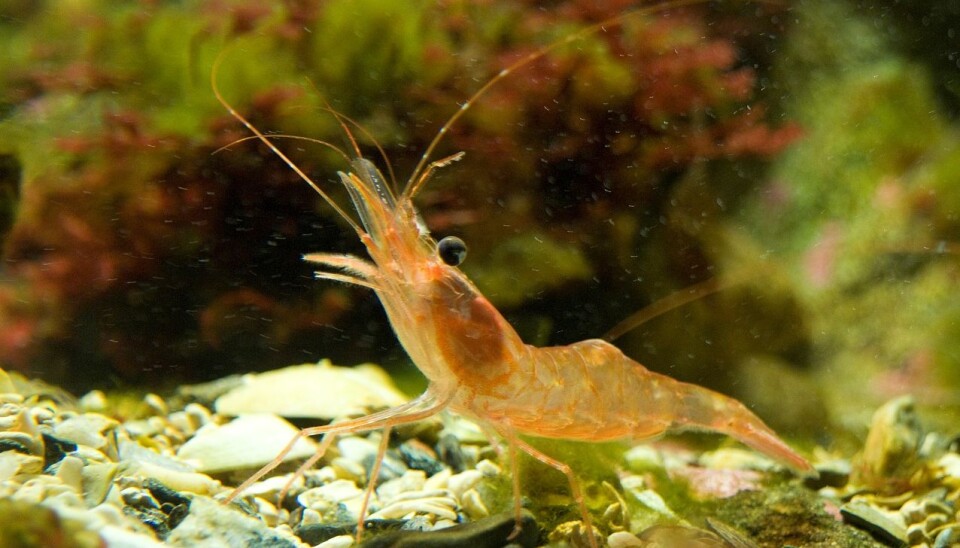An article from University of Tromsø – The Arctic University of Norway

The Shrimp as a Climate Gauge
The deepwater shrimp could prove to be one of the most sensitive gauges of climate change.
Denne artikkelen er over ti år gammel og kan inneholde utdatert informasjon.
You might not give it a thought when you enjoy the pink delicacies of the sea with a nice chilled glass of white wine.
But if the shrimp disappears from the Norwegian lunches, we can safely assume that the North Atlantic has become warmer.
An article in Science earlier this year concludes that monitoring shrimp population development will be an important part of analysing the consequences of climate change on marine life.
Like canaries in the mine
The deepwater shrimp, Pandalus borealis, occupies a central place in many of the food chains found in the North Atlantic. At the same time, it is the target of one of the world’s largest fisheries, with an annual value of more than 385 million Euros.
The shrimp larvae eat plant plankton, the tiny organisms which are the foundation for all life in the ocean, while the shrimp in turn are eaten by cod and other commercially important fish.
“As a result of its central place in the food chain, the shrimp is the marine equivalent of the canaries which were used as an early warning system to detect gas leaks in coal mines in the past,” says Professor Michaela Aschan at the University of Tromsø (UiT).
She has participated in an inter-disciplinary, international research group examining the shrimp as a climate gauge.
“While canaries are very sensitive to methane and carbon monoxide, shrimp are very sensitive to small changes in temperature. We can see how these changes affect shrimp before we see the effect in other species,” she says.
Pre-programmed reactions
The Science article reports that, all over the North Atlantic, shrimp larvae hatch during the spring days with the most phytoplankton. But it is not the chemical sediments from phytoplankton that tell the shrimp eggs to hatch. The shrimp are pre-programmed to react to changes in sea temperature.
When the female shrimp spawn depends on the seabed temperature, while the hatching of the eggs is also triggered by light. When the eggs hatch, the larvae move to the surface to feed. They feed five to 20 metres below the surface.
The hatching of the shrimp eggs greatly depends on the area. Usually, they do not hatch later than a week after the increase in phytoplankton, so this is very well timed.
"They are not cunning and they do not have a brain, but evolution has programmed them to adapt to the influx of phytoplankton. But what will happen if there is a sudden change in temperature?” Micheala Ashan asks.
Mismatches have been observed
It is important that zooplankton, including shrimp, do not arrive too soon in relation to the phytoplankton. They have to match their arrival to the phytoplankton in order to extract the most nutritional value from the plant plankton. If their timing is off, we have what biologists refer to as a mismatch.
In the northern part of the Barents Sea, the water is at its coldest close to the surface, while the bottom water is warmer. If global warming causes a significant rise in the temperature of the bottom layers, the eggs will hatch earlier and rise towards the cold surface water.
Since the surface water is not warmed at the same pace, the spring hatching will not have occurred and the larvae will starve to death.
Or global warming of the surface water could change the time of the spring hatching, and potentially disconnect fine-tuned balance between the hatching and the access to food which the shrimp have developed over a very long time.
Such mismatches have already been observed in some places.
For four consecutive years, the scientists saw larvae dying from starvation in the Gulf of Main. The area has poor population replenishment, and it shows that the shrimp need time to adapt genetically. Here the shrimp larvae hatch very close to, and even before, the spring flourishing, so the margins are very small.
“It is actually kind of remarkable that the shrimp have done so well. In some areas the spring flourishing starts in March, other areas in May. That’s a two month difference that shrimp in the various areas have managed to adapt to.
And who knows, if the global warming of the oceans happens slowly, maybe they can adapt again,” says Michaela Aschan.






























